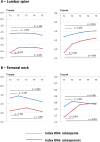Evolution of bone densitometry parameters and risk of fracture in coeliac disease: a 10-year perspective
- PMID: 37269445
- PMCID: PMC10412678
- DOI: 10.1007/s11739-023-03307-7
Evolution of bone densitometry parameters and risk of fracture in coeliac disease: a 10-year perspective
Abstract
Background: Metabolic bone disease is frequently found in patients with coeliac disease (CD). Despite its high prevalence, international guidelines are partially discordant about its management due to the lack of long-term data.
Methods: We retrospectively evaluated a large dataset of prospectively collected data of CD patients assessing the variation of DXA parameters and estimated fracture risk according to the FRAX® score in a 10-year follow-up. Incident fractures are reported, and the predictive ability of the FRAX® score is verified.
Results: We identified 107 patients with low bone density (BMD) at the diagnosis of CD and a 10-year follow-up. After improving at the first follow-up, T-scores slowly reduced over time but with no clinically relevant differences between the first and last examination (lumbar spine: from - 2.07 to - 2.07, p = 1.000; femoral neck: from - 1.37 to - 1.55, p = 0.006). Patients with osteoporosis at the index measurement had more marked fluctuations than those with osteopenia; the latter group also showed minimal modifications of the FRAX® score over time. Six incident major fragility fractures occurred, with a good predictive ability of the FRAX® (AUC 0.826).
Conclusion: Adult CD patients with osteopenia and no risk factors had substantially stable DXA parameters and fracture risk during a 10-year follow-up. A dilated interval between follow-up DXA for these patients could be considered to reduce diagnosis-related time and costs, maintaining a 2-year interval for patients with osteoporosis or risk factors.
Keywords: Bone; Coeliac disease; Dual-energy X-ray absorptiometry; Fractures; Gluten; Gluten-free diet; Osteoporosis.
© 2023. The Author(s).
Conflict of interest statement
All authors have declared no conflicts of interest.
Figures




References
MeSH terms
LinkOut - more resources
Full Text Sources
Medical

